Shimin Zhang
TC-LIF: A Two-Compartment Spiking Neuron Model for Long-term Sequential Modelling
Aug 25, 2023Abstract:The identification of sensory cues associated with potential opportunities and dangers is frequently complicated by unrelated events that separate useful cues by long delays. As a result, it remains a challenging task for state-of-the-art spiking neural networks (SNNs) to establish long-term temporal dependency between distant cues. To address this challenge, we propose a novel biologically inspired Two-Compartment Leaky Integrate-and-Fire spiking neuron model, dubbed TC-LIF. The proposed model incorporates carefully designed somatic and dendritic compartments that are tailored to facilitate learning long-term temporal dependencies. Furthermore, a theoretical analysis is provided to validate the effectiveness of TC-LIF in propagating error gradients over an extended temporal duration. Our experimental results, on a diverse range of temporal classification tasks, demonstrate superior temporal classification capability, rapid training convergence, and high energy efficiency of the proposed TC-LIF model. Therefore, this work opens up a myriad of opportunities for solving challenging temporal processing tasks on emerging neuromorphic computing systems.
Four years of multi-modal odometry and mapping on the rail vehicles
Aug 22, 2023Abstract:Precise, seamless, and efficient train localization as well as long-term railway environment monitoring is the essential property towards reliability, availability, maintainability, and safety (RAMS) engineering for railroad systems. Simultaneous localization and mapping (SLAM) is right at the core of solving the two problems concurrently. In this end, we propose a high-performance and versatile multi-modal framework in this paper, targeted for the odometry and mapping task for various rail vehicles. Our system is built atop an inertial-centric state estimator that tightly couples light detection and ranging (LiDAR), visual, optionally satellite navigation and map-based localization information with the convenience and extendibility of loosely coupled methods. The inertial sensors IMU and wheel encoder are treated as the primary sensor, which achieves the observations from subsystems to constrain the accelerometer and gyroscope biases. Compared to point-only LiDAR-inertial methods, our approach leverages more geometry information by introducing both track plane and electric power pillars into state estimation. The Visual-inertial subsystem also utilizes the environmental structure information by employing both lines and points. Besides, the method is capable of handling sensor failures by automatic reconfiguration bypassing failure modules. Our proposed method has been extensively tested in the long-during railway environments over four years, including general-speed, high-speed and metro, both passenger and freight traffic are investigated. Further, we aim to share, in an open way, the experience, problems, and successes of our group with the robotics community so that those that work in such environments can avoid these errors. In this view, we open source some of the datasets to benefit the research community.
Long Short-term Memory with Two-Compartment Spiking Neuron
Jul 14, 2023Abstract:The identification of sensory cues associated with potential opportunities and dangers is frequently complicated by unrelated events that separate useful cues by long delays. As a result, it remains a challenging task for state-of-the-art spiking neural networks (SNNs) to identify long-term temporal dependencies since bridging the temporal gap necessitates an extended memory capacity. To address this challenge, we propose a novel biologically inspired Long Short-Term Memory Leaky Integrate-and-Fire spiking neuron model, dubbed LSTM-LIF. Our model incorporates carefully designed somatic and dendritic compartments that are tailored to retain short- and long-term memories. The theoretical analysis further confirms its effectiveness in addressing the notorious vanishing gradient problem. Our experimental results, on a diverse range of temporal classification tasks, demonstrate superior temporal classification capability, rapid training convergence, strong network generalizability, and high energy efficiency of the proposed LSTM-LIF model. This work, therefore, opens up a myriad of opportunities for resolving challenging temporal processing tasks on emerging neuromorphic computing machines.
TEA-PSE 3.0: Tencent-Ethereal-Audio-Lab Personalized Speech Enhancement System For ICASSP 2023 DNS Challenge
Mar 14, 2023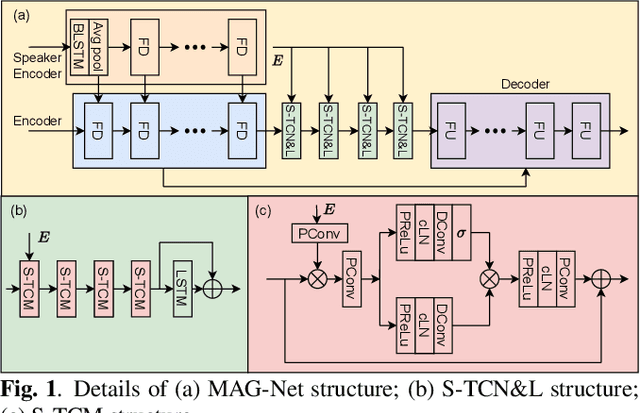


Abstract:This paper introduces the Unbeatable Team's submission to the ICASSP 2023 Deep Noise Suppression (DNS) Challenge. We expand our previous work, TEA-PSE, to its upgraded version -- TEA-PSE 3.0. Specifically, TEA-PSE 3.0 incorporates a residual LSTM after squeezed temporal convolution network (S-TCN) to enhance sequence modeling capabilities. Additionally, the local-global representation (LGR) structure is introduced to boost speaker information extraction, and multi-STFT resolution loss is used to effectively capture the time-frequency characteristics of the speech signals. Moreover, retraining methods are employed based on the freeze training strategy to fine-tune the system. According to the official results, TEA-PSE 3.0 ranks 1st in both ICASSP 2023 DNS-Challenge track 1 and track 2.
Two-step Band-split Neural Network Approach for Full-band Residual Echo Suppression
Mar 13, 2023

Abstract:This paper describes a Two-step Band-split Neural Network (TBNN) approach for full-band acoustic echo cancellation. Specifically, after linear filtering, we split the full-band signal into wide-band (16KHz) and high-band (16-48KHz) for residual echo removal with lower modeling difficulty. The wide-band signal is processed by an updated gated convolutional recurrent network (GCRN) with U$^2$ encoder while the high-band signal is processed by a high-band post-filter net with lower complexity. Our approach submitted to ICASSP 2023 AEC Challenge has achieved an overall mean opinion score (MOS) of 4.344 and a word accuracy (WAcc) ratio of 0.795, leading to the 2$^{nd}$ (tied) in the ranking of the non-personalized track.
Personalized Acoustic Echo Cancellation for Full-duplex Communications
May 30, 2022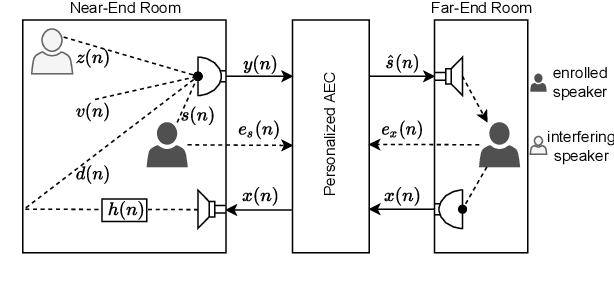
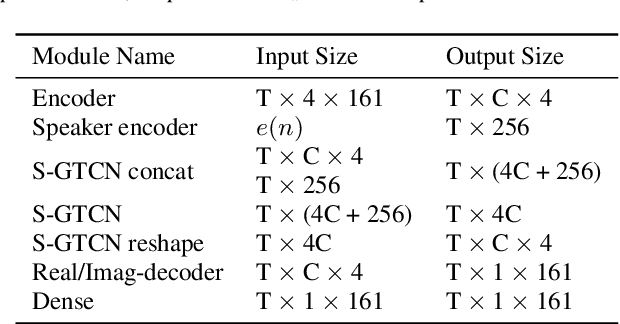

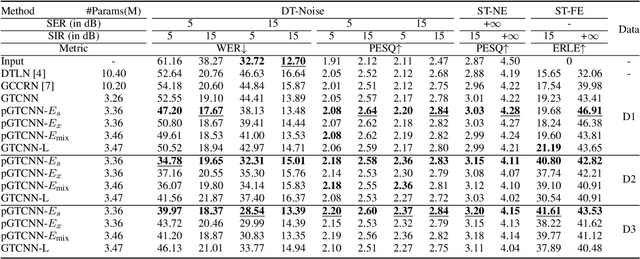
Abstract:Deep neural networks (DNNs) have shown promising results for acoustic echo cancellation (AEC). But the DNN-based AEC models let through all near-end speakers including the interfering speech. In light of recent studies on personalized speech enhancement, we investigate the feasibility of personalized acoustic echo cancellation (PAEC) in this paper for full-duplex communications, where background noise and interfering speakers may coexist with acoustic echoes. Specifically, we first propose a novel backbone neural network termed as gated temporal convolutional neural network (GTCNN) that outperforms state-of-the-art AEC models in performance. Speaker embeddings like d-vectors are further adopted as auxiliary information to guide the GTCNN to focus on the target speaker. A special case in PAEC is that speech snippets of both parties on the call are enrolled. Experimental results show that auxiliary information from either the near-end speaker or the far-end speaker can improve the DNN-based AEC performance. Nevertheless, there is still much room for improvement in the utilization of the finite-dimensional speaker embeddings.
Multi-Task Deep Residual Echo Suppression with Echo-aware Loss
Feb 21, 2022
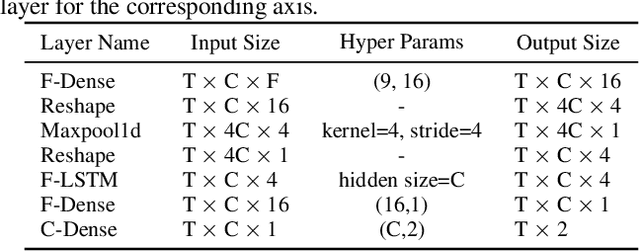
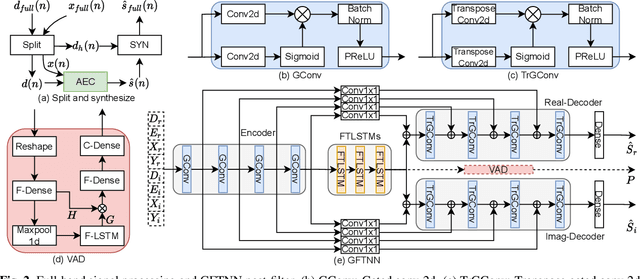

Abstract:This paper introduces the NWPU Team's entry to the ICASSP 2022 AEC Challenge. We take a hybrid approach that cascades a linear AEC with a neural post-filter. The former is used to deal with the linear echo components while the latter suppresses the residual non-linear echo components. We use gated convolutional F-T-LSTM neural network (GFTNN) as the backbone and shape the post-filter by a multi-task learning (MTL) framework, where a voice activity detection (VAD) module is adopted as an auxiliary task along with echo suppression, with the aim to avoid over suppression that may cause speech distortion. Moreover, we adopt an echo-aware loss function, where the mean square error (MSE) loss can be optimized particularly for every time-frequency bin (TF-bin) according to the signal-to-echo ratio (SER), leading to further suppression on the echo. Extensive ablation study shows that the time delay estimation (TDE) module in neural post-filter leads to better perceptual quality, and an adaptive filter with better convergence will bring consistent performance gain for the post-filter. Besides, we find that using the linear echo as the input of our neural post-filter is a better choice than using the reference signal directly. In the ICASSP 2022 AEC-Challenge, our approach has ranked the 1st place on word accuracy (WAcc) (0.817) and the 3rd place on both mean opinion score (MOS) (4.502) and the final score (0.864).
Simultaneous Location of Rail Vehicles and Mapping of Environment with Multiple LiDARs
Dec 25, 2021



Abstract:Precise and real-time rail vehicle localization as well as railway environment monitoring is crucial for railroad safety. In this letter, we propose a multi-LiDAR based simultaneous localization and mapping (SLAM) system for railway applications. Our approach starts with measurements preprocessing to denoise and synchronize multiple LiDAR inputs. Different frame-to-frame registration methods are used according to the LiDAR placement. In addition, we leverage the plane constraints from extracted rail tracks to improve the system accuracy. The local map is further aligned with global map utilizing absolute position measurements. Considering the unavoidable metal abrasion and screw loosening, online extrinsic refinement is awakened for long-during operation. The proposed method is extensively verified on datasets gathered over 3000 km. The results demonstrate that the proposed system achieves accurate and robust localization together with effective mapping for large-scale environments. Our system has already been applied to a freight traffic railroad for monitoring tasks.
RailLoMer: Rail Vehicle Localization and Mapping with LiDAR-IMU-Odometer-GNSS Data Fusion
Nov 30, 2021



Abstract:We present RailLoMer in this article, to achieve real-time accurate and robust odometry and mapping for rail vehicles. RailLoMer receives measurements from two LiDARs, an IMU, train odometer, and a global navigation satellite system (GNSS) receiver. As frontend, the estimated motion from IMU/odometer preintegration de-skews the denoised point clouds and produces initial guess for frame-to-frame LiDAR odometry. As backend, a sliding window based factor graph is formulated to jointly optimize multi-modal information. In addition, we leverage the plane constraints from extracted rail tracks and the structure appearance descriptor to further improve the system robustness against repetitive structures. To ensure a globally-consistent and less blurry mapping result, we develop a two-stage mapping method that first performs scan-to-map in local scale, then utilizes the GNSS information to register the submaps. The proposed method is extensively evaluated on datasets gathered for a long time range over numerous scales and scenarios, and show that RailLoMer delivers decimeter-grade localization accuracy even in large or degenerated environments. We also integrate RailLoMer into an interactive train state and railway monitoring system prototype design, which has already been deployed to an experimental freight traffic railroad.
DCCRN+: Channel-wise Subband DCCRN with SNR Estimation for Speech Enhancement
Jun 16, 2021
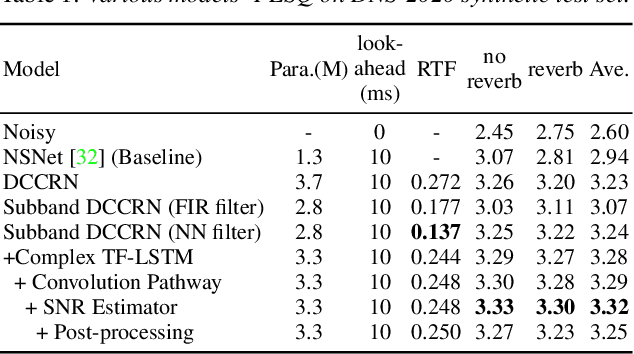
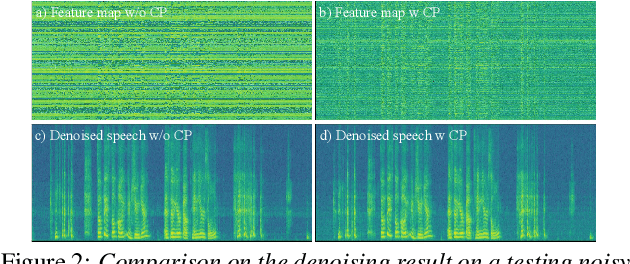
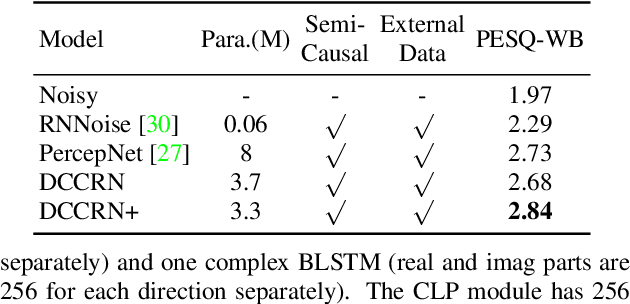
Abstract:Deep complex convolution recurrent network (DCCRN), which extends CRN with complex structure, has achieved superior performance in MOS evaluation in Interspeech 2020 deep noise suppression challenge (DNS2020). This paper further extends DCCRN with the following significant revisions. We first extend the model to sub-band processing where the bands are split and merged by learnable neural network filters instead of engineered FIR filters, leading to a faster noise suppressor trained in an end-to-end manner. Then the LSTM is further substituted with a complex TF-LSTM to better model temporal dependencies along both time and frequency axes. Moreover, instead of simply concatenating the output of each encoder layer to the input of the corresponding decoder layer, we use convolution blocks to first aggregate essential information from the encoder output before feeding it to the decoder layers. We specifically formulate the decoder with an extra a priori SNR estimation module to maintain good speech quality while removing noise. Finally a post-processing module is adopted to further suppress the unnatural residual noise. The new model, named DCCRN+, has surpassed the original DCCRN as well as several competitive models in terms of PESQ and DNSMOS, and has achieved superior performance in the new Interspeech 2021 DNS challenge
 Add to Chrome
Add to Chrome Add to Firefox
Add to Firefox Add to Edge
Add to Edge